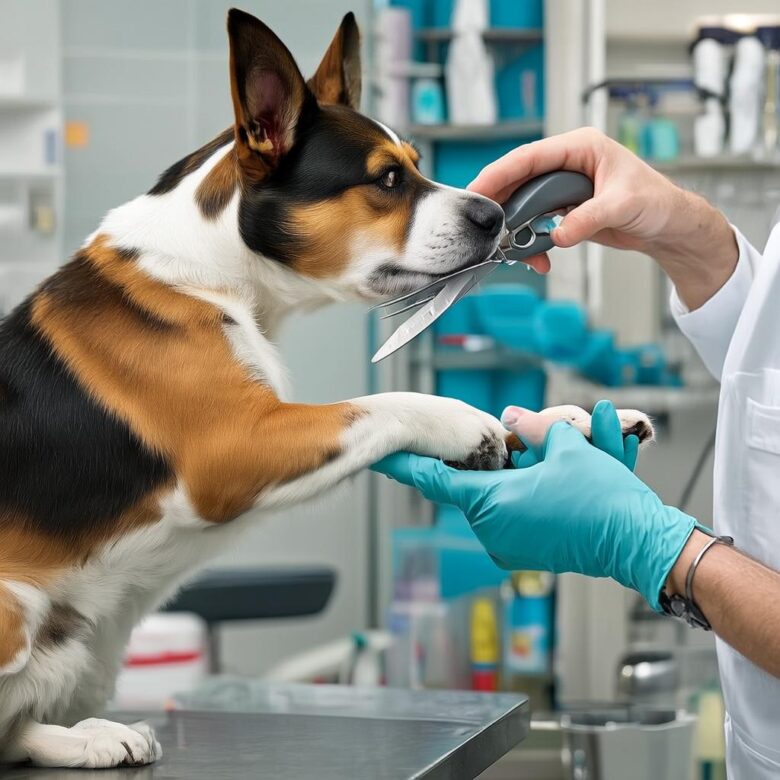Introduction to Nail Care for Dogs
Nail care is an essential aspect of pet ownership that significantly contributes to a dog’s overall health and well-being. Regular nail trimming not only prevents discomfort but also plays a critical role in maintaining proper posture and minimizing the risk of injuries. When dogs’ nails grow too long, it can lead to a variety of health issues, including pain, foot infection, or problems with walking. Additionally, neglected nails can possibly cause joint issues due to unnatural pressure being exerted on the feet and legs. Therefore, it is fundamental to prioritize nail care as part of a holistic health regimen for pets.
Understanding the importance of proper nail care is crucial for every dog owner. Not only does routine nail trimming enhance your dog’s comfort level, but it also fosters a closer bond between you and your pet. A successful and stress-free nail-cutting session can transform into a positive experience, fostering trust and cooperation during future grooming routines. Throughout this blog post, we will discuss the various tools available for trimming your dog’s nails, tips for ensuring a stress-free experience, and how to recognize when professional help may be necessary.
By learning the techniques and signs of proper nail lengths, pet owners can be better equipped to take charge of their dogs’ grooming needs. As we delve deeper into this topic, it is important to remember that nail care is not just about aesthetic; it is fundamentally tied to the health of your beloved pet. Ensuring that nails are trimmed to an appropriate length will contribute positively to a dog’s mobility and overall quality of life. Embracing these practices creates a foundation for a happy, healthy dog.
The Importance of Regular Nail Trimming
Nail trimming is a fundamental aspect of pet care that significantly contributes to the overall well-being of dogs. Regular nail care is essential for maintaining your pet’s comfort and mobility. When a dog’s nails grow too long, they can cause a range of health issues that may lead to pain and behavioral complications. Long nails can become a source of discomfort as they press against the paw pads and may even curl and grow into the skin, leading to painful infections.
Moreover, neglecting the nails can affect a dog’s ability to walk comfortably. Over time, elongated nails can alter the way a dog distributes its weight while standing or moving, potentially leading to joint issues and other orthopedic concerns. This is particularly crucial for active breeds that require regular exercise. Ensuring your dog’s nails are kept short not only promotes better mobility but also allows for safer outdoor activities. Your pet’s enjoyment of playtime activities can genuinely depend on this simple yet essential aspect of grooming.
Beyond physical health, behavioral issues can arise from improper nail maintenance. Dogs with long, uncomfortable nails may exhibit anxiety and hesitation around certain surfaces, which can hinder their exploration and interaction with their environment. Additionally, a dog may exhibit signs of distress, leading to a negative association with grooming routines. Regular nail trimming can thus help maintain your dog’s quality of life, fostering a more relaxed and confident pet.
It is advisable to establish a routine for nail care as part of your dog’s regular grooming schedule. This attention to your pet’s nail health not only minimizes the risk of complications but also strengthens the bond between you and your furry friend. Incorporating nail trimming into your dog’s regular care will ultimately lead to a happier, healthier pet.
How to Safely Cut Your Dog’s Nails
Cutting your dog’s nails is an essential part of maintaining its health and hygiene. To ensure a safe and effective grooming session, having the right tools is crucial. You will need a pair of quality dog nail clippers, a nail file or grinder for smoothing rough edges, and styptic powder for addressing any minor bleeding that may occur if you accidentally cut too close to the quick. Always ensure that the tools are clean and in good condition to avoid any complications.
Before you start, it is important to create a calm environment for your pet. Begin the session by allowing your dog to get comfortable with you handling its paws. You might find it helpful to use treats to positively reinforce the experience; this not only keeps your dog relaxed but also helps to associate nail cutting with positive experiences. If your dog shows signs of anxiety, consider using a calmative product or seeking the assistance of a professional groomer.
When you are ready, hold the paw firmly but gently and identify the quick, which is the pink section of the nail that contains nerves and blood vessels. Cut only the tip of the nail, avoiding the quick. For dogs with dark nails, be especially cautious, as you may not be able to see the quick. Regularly check your dog’s nails, as healthy nails should be trimmed every three to four weeks, although this might differ based on your dog’s activity level or lifestyle.
Finally, always reward your dog with praise or treats after each nail trimming session to create a positive reinforcement loop for future nail care. Engaging in this routine will not only aid in maintaining your pet’s nail health but will also foster a trusting relationship between you and your dog. Share your experiences or ask for tips in the comments below, as your insights might help fellow pet owners in their grooming journeys!
FAQ and Conclusion
When it comes to cutting your dog’s nails, many pet owners have questions that require clear answers. One common question is, “How often should I cut my dog’s nails?” The frequency can vary depending on the dog’s activity level and the surfaces they walk on. Generally, nails should be trimmed every 3 to 4 weeks to prevent overgrowth, which can lead to health issues for your pet. Keeping track of your dog’s nail length will help you determine the right schedule for nail care.
Another frequently asked question is, “What tools are best for cutting dog nails?” There are various tools available, including nail clippers, grinders, and scissors designed specifically for pets. Selecting the right tool depends on your dog’s size and comfort level. Smaller breeds may require smaller clippers, while larger breeds might benefit from grinders that smooth the edges after cutting.
Pet owners may also wonder, “What if I accidentally cut too close?” It’s essential to stay calm if you accidently cut the quick—the sensitive part of the nail that contains blood vessels and nerves. Applying a styptic powder can stop the bleeding, and keeping your dog calm and relaxed will help ease any stress they may experience.
In conclusion, maintaining proper nail care is crucial for your dog’s overall health. Regular nail trimming not only prevents discomfort but also contributes to improved mobility. As a dog owner, prioritizing your pet’s needs includes understanding the importance of nail care and utilizing the proper techniques and tools. For more information on this topic and related pet care tips, feel free to explore further content on our site.

